





 |
 |
 |
 |
 |
 |
| Greg Lavaty | profile | all galleries >> My Blog >> The Colorful Visitors of Spring Migration on the Upper Texas Coast Part 1 03-12-2013 | tree view | thumbnails | slideshow |
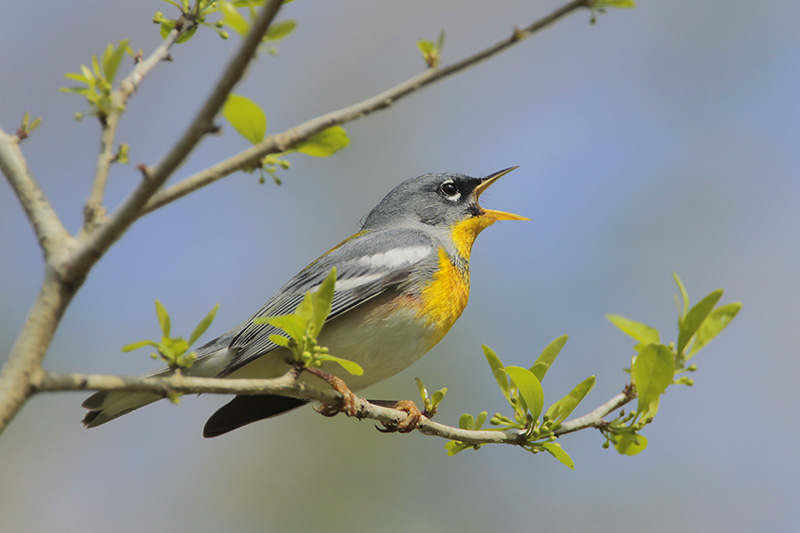
Every spring people come to the upper Texas coast from all over the world in hopes of seeing the marvel of songbird migration. No other group of birds that passes through our area offers as much of a variety of colors and patterns as the warblers. For this reason this large group of tiny birds are the most sought-after by birders.
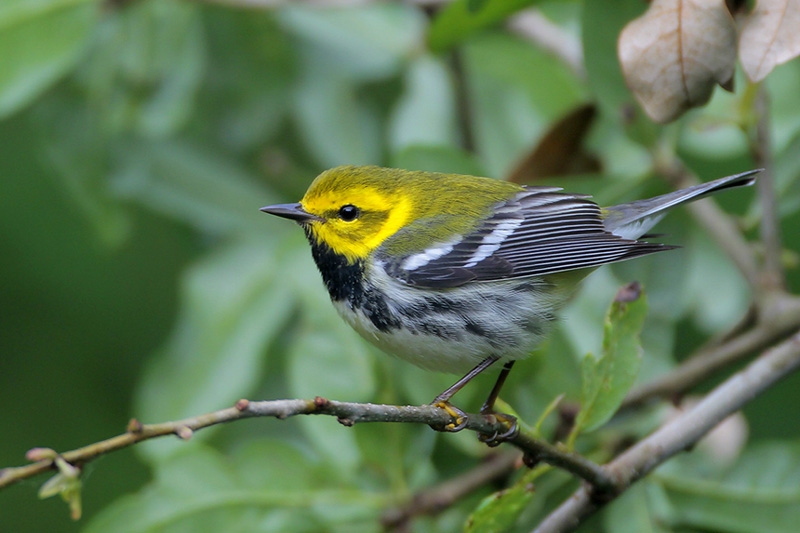
During spring a total of 38 species of warblers are expected on the upper Texas coast and in some years there can be even more. The shear number of species combined with the fact that many warblers are sexually dimorphic, many have breeding and non-breeding plumages, and that immature birds often look different from their parents make warblers a significant ID challenge for new birders. It also doesn’t help that many of the warblers prefer to spend their time high in the canopy darting around the branches and leaves in search of much-needed food to continue the journey to their breeding grounds. The term “warbler neck” comes from the pain birders feel after having spent all day staring up into the trees in hopes of getting good enough views to identify all the species of warblers that are in the area.
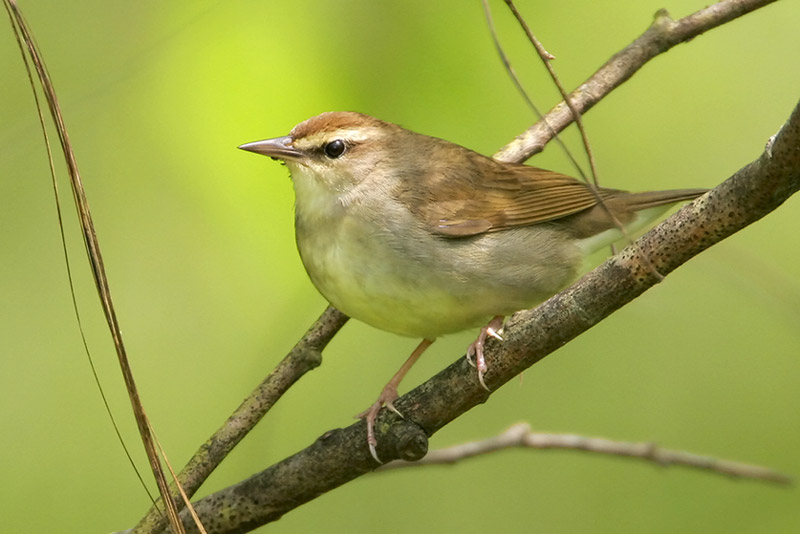
With migration starting up I would like to offer birders a brief explanation of how to identify the warblers they will hopefully see on the upper Texas coast this coming spring. Migration in Texas basically starts in mid to late February when birds like Purple Martins start showing up. The “spring warblers” start showing up in early March and continue through the month of May. By the beginning of June the warblers that don’t breed in our area have pretty much all passed through and won’t be back again until late July or August.
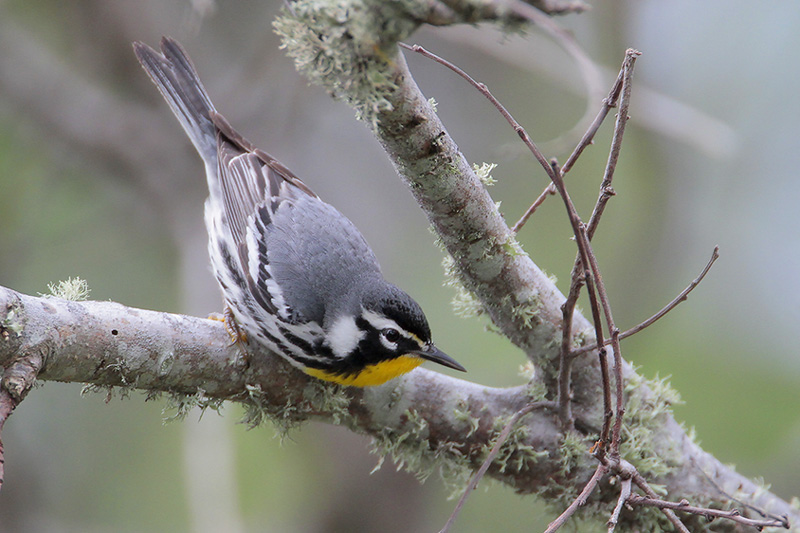
Here I will start with the early migrants that are in our area from around the second week in March through the first week or so in May. Warblers present at this time are either winter residents (Yellow-rumped Warbler, Orange-crowned Warbler, Palm Warbler, Wilson’s Warbler and to a small degree Northern Waterthrush and Black-and-white Warbler), year around residents (Pine Warbler & Common Yellowthroat) or species that breed in the southern part of the US (Blue-winged Warbler, Nashville Warbler, Northern Parula, Black-throated Green Warbler, Yellow-throated Warbler, Black-and-white Warbler, Prothonotary Warbler, Swainson’s Warbler, Louisiana Waterthrush, Kentucky Warbler and Hooded Warbler).
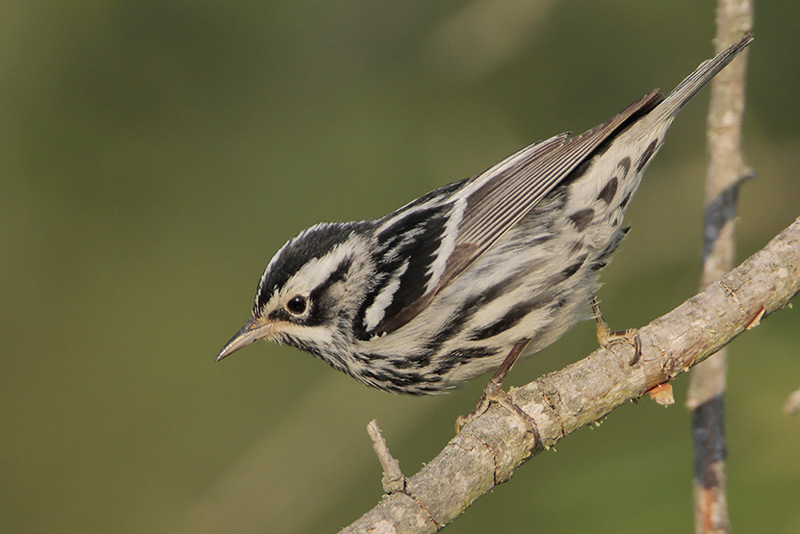
For each species I am including three initial sections in the following form:
(when they are expected on the upper Texas coast) [habitat favored by the species during migration] {foraging behavior}
Of the winter residents, the most abundant are the Yellow-rumped and Orange-crowned Warblers.
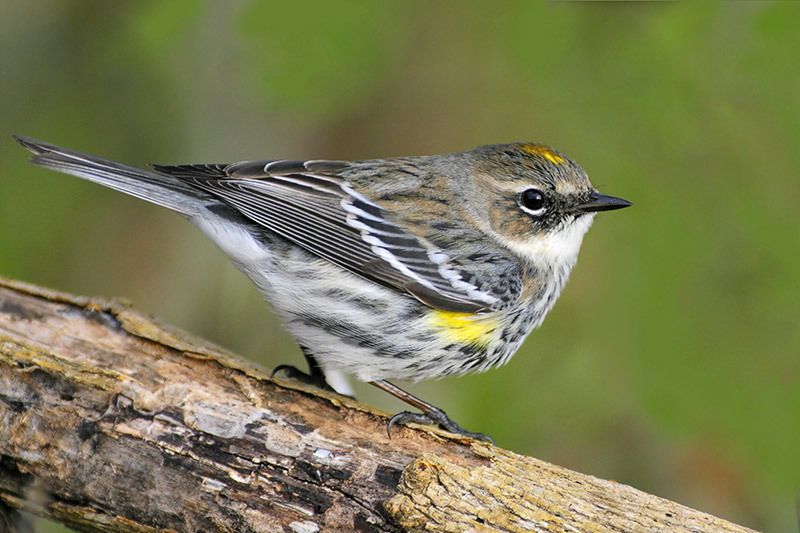
Yellow-rumped Warbler (winter through mid-April) [wooded areas and scrub] {feeds at all levels from the ground to the treetops, eating both insects and berries}
In the US they come in two major groups. The eastern birds, which are common on the upper Texas coast, are known as “myrtle warblers” and when they are here they normally have non-breeding plumage. The most obvious feature of Yellow-rumped Warblers is the conspicuous yellow patch on the bird’s rump.
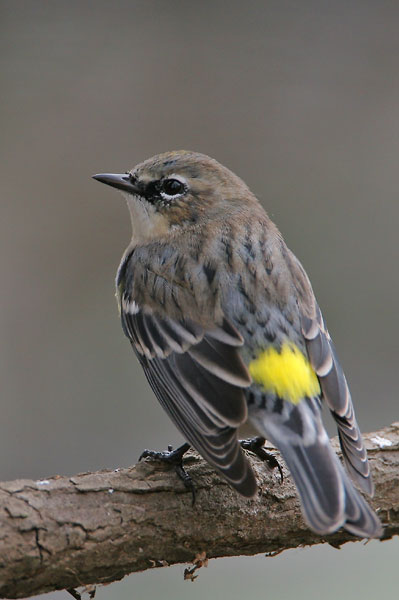
The rump patch is also obvious in flight:
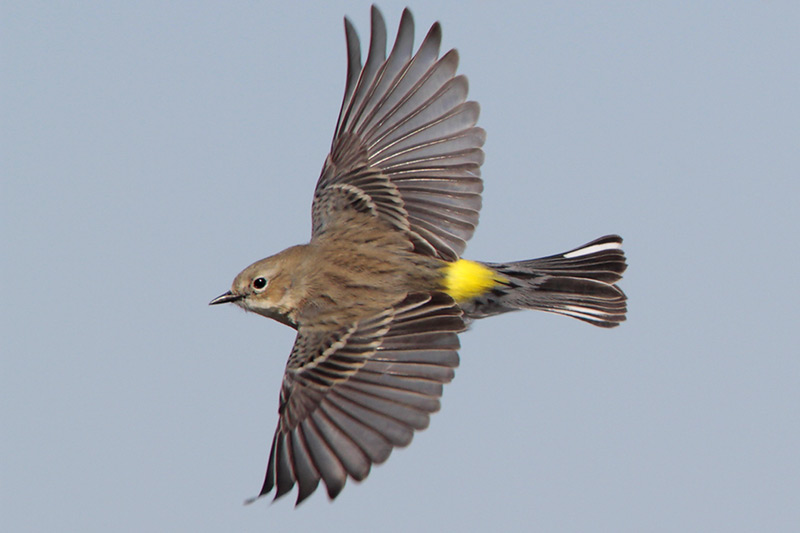
Yellow-rumped Warblers also show yellow spots on their crown and sides, most obvious in adult males:

Female and immature birds often show little to no yellow on the crown and sides:
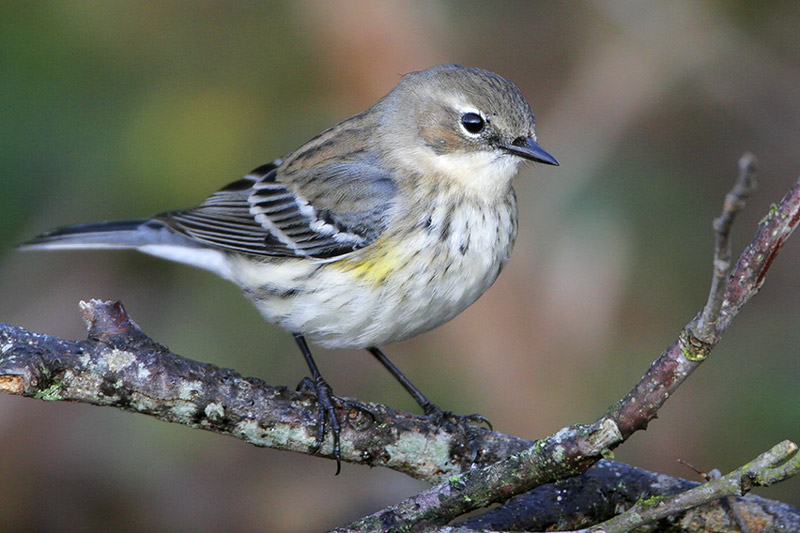
Overall female birds are duller than males and first-year females being duller still:
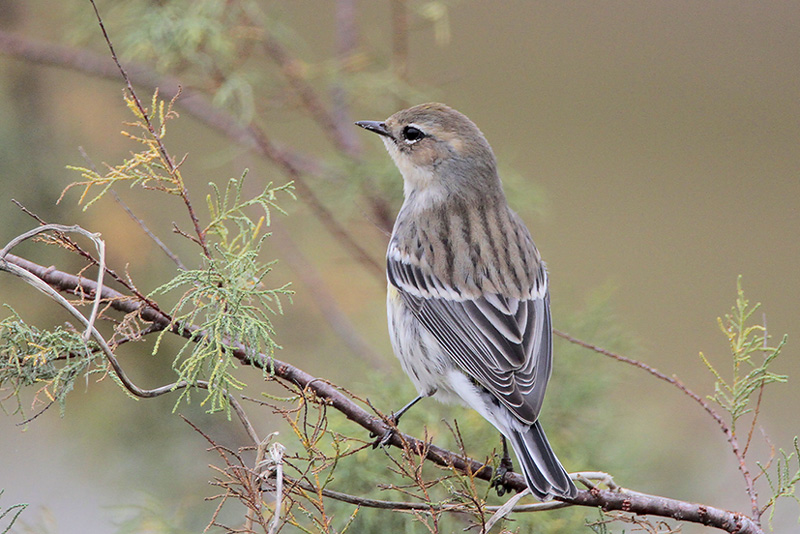
In April it is likely that you will encounter myrtle warblers that are molting into their breeding plumage as this bird seen on April 16 near Sabine Pass, TX.

and this bird from Galveston, TX on April 28

Myrtle warblers have an overall dark tail with white spots near the end of the tail-feathers:

The pattern on the underside of the folded tail is also fairly distinctive as can be seen in this young female:
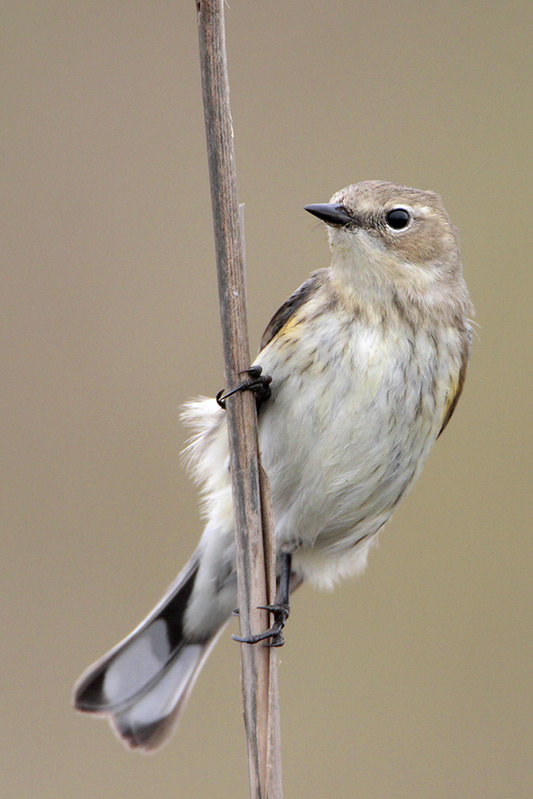
You might encounter an Audubon’s Yellow-rumped Warbler (the western subspecies) though they are rare on the UTC. These can usually be easily be distinguished from myrtle warblers by their yellow throat. Myrtle warblers always have a white throat. The yellow throat can, however, be difficult or nearly impossible to distinguish in dull first year female Audubon’s warblers making them difficult to distinguish. In this case the lack of thin white supercilium would indicate an Audubon’s warbler.

To see more of this species click here

Orange-crowned Warbler (Winter through mid-April) [scrub and woodlands] {feeds at all levels from low in the scrub to high in the canopy}
Orange-crowns come in a variety of different forms but the differences aren’t quite as dramatic as those between the myrtle and Audubon’s Yellow-rumped Warblers. Male and female birds look similar. Probably one of the most distinct features of the Orange-crowned Warbler is the lack of distinctive features. They are typically drab grayish yellow to yellow-olive birds with a small pointed beak and a broken eye-ring.

Despite their name, the orange crown patch is rarely seen unless the bird’s crest is raised.

The underside of their tail is unmarked and the undertail coverts are yellow.

To see more of this species click here
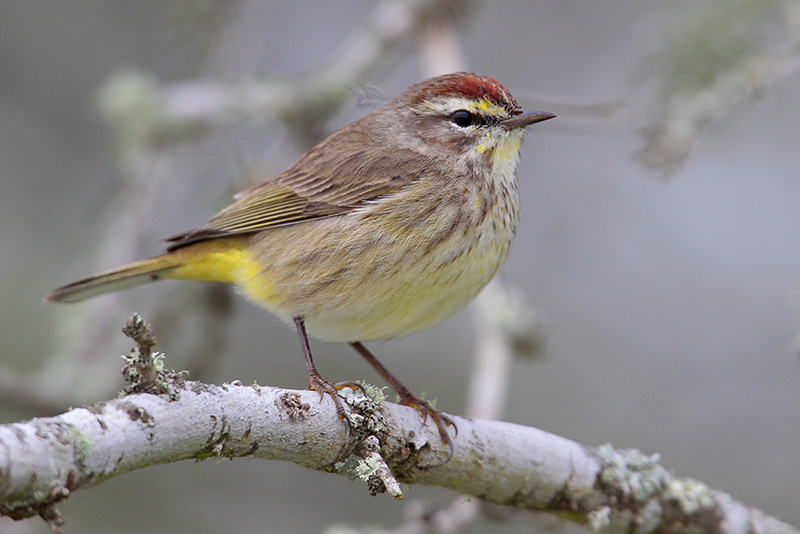
Palm Warbler (Winter through mid-April) [short grass, weedy fields and other relatively open areas] {feeds mostly on the ground, wagging its tail like a pipit but hops rather than walks}
One of our less common winter residents is the Palm Warbler. The birds we typically encounter on the upper Texas coast belong to the mode colorful eastern subspecies. They are typically found in open grassy or weedy areas, often with standing water and are usually found on or near the ground. While foraging they frequently pump their tail. Male and female birds look similar.

Some of our winter birds are of the western variety as this one seen at Brazos Bend State Park on December 19.

Our Palm Warblers have an overall yellowish appearance with a yellow throat, yellow rump, faint fine streaking on the sides and usually yellowish underparts. They have a brown crown that has a few rufous feathers interspersed. Some winter birds are quite dull as this one from San Bernard NWR on January 9.

April birds usually have more of a brown/tan appearance and show a rufous crown as can be seen in this bird from Quintana, TX on April 9:

and this bird from April 23 at High Island, TX
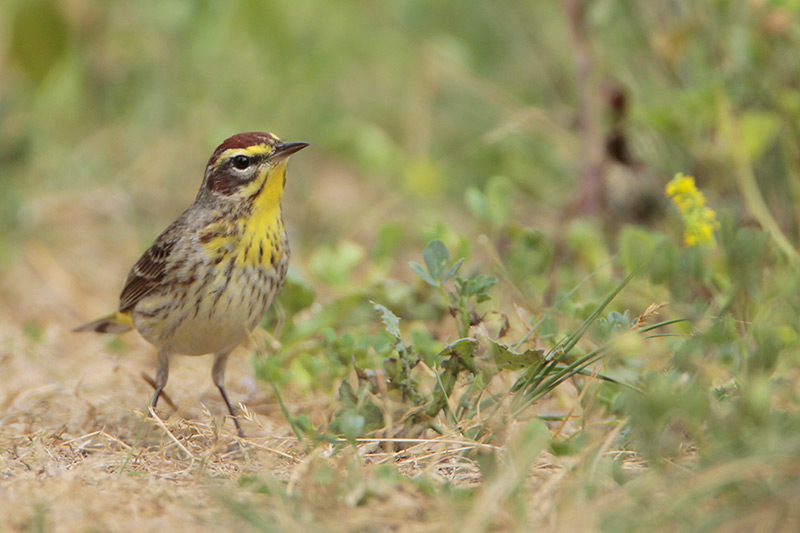
Palm Warblers have a dark undertail with white spots similar to Yellow-rumped Warblers.

To see more of this species click here
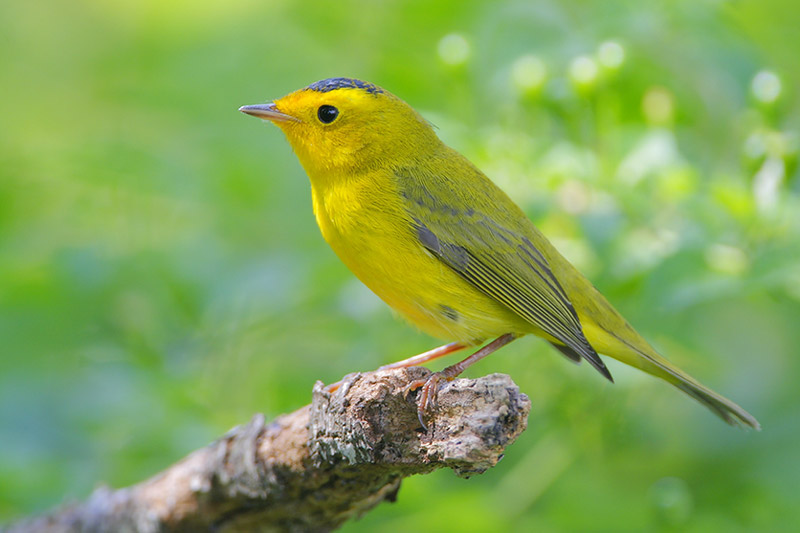
Wilson’s Warbler (winter through the first week of May) [wooded areas with plenty of undergrowth and tall scrub] {feeds at low to mid levels usually in undergrowth}
Another of our regular but less frequently seen winter residents is the Wilson’s Warbler. These birds can usually be found on the UTC through the first week of May in small numbers.
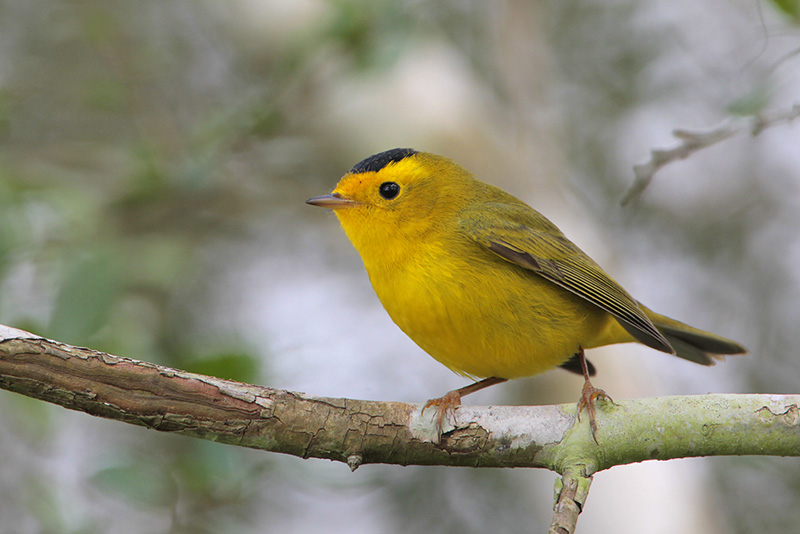
They are typically found in wooded areas with lots of scrubby vegetation. Wilson’s Warblers are sexually dimorphic. The adult male is yellow with a small black cap.

The adult female looks similar to the male but with a faint cap.
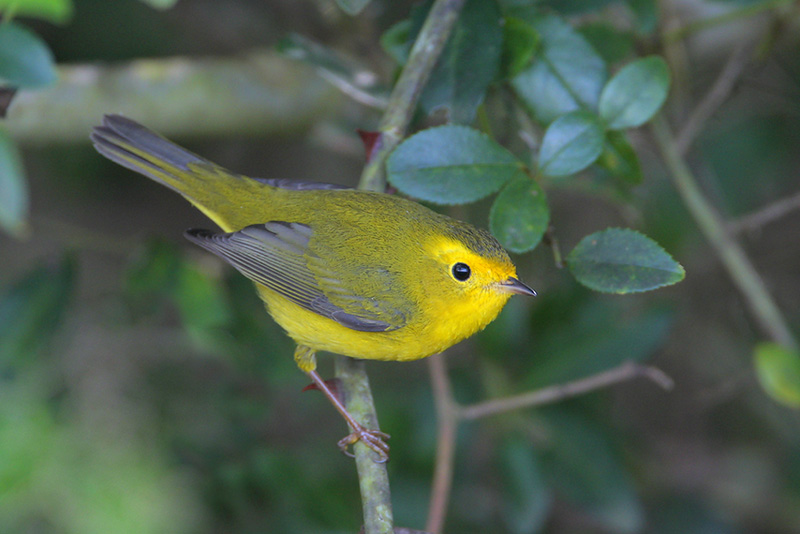
First-year females have almost no sign at all of a cap and can be confused with female hooded Warblers. The shape of the bird and in particular its smaller, flatter beak and paler lores help to separate it from Hooded Warbler.

Compared to young female Hooded Warbler here, note the beak and darker lores.
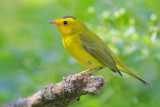
To see more of this species click here
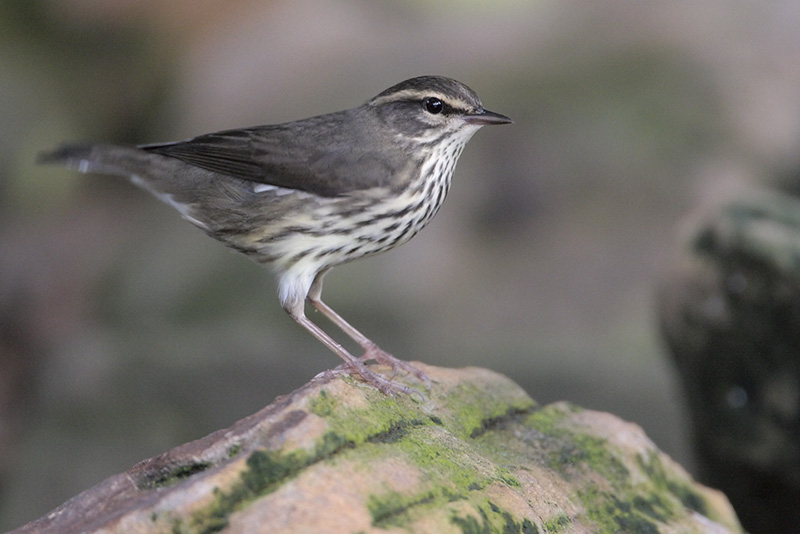
Northern Waterthrush (migrants usually arrive around the first week of April through mid-May) [similar habitat to Louisiana Waterthrush] {similar to Louisiana Waterthrush}
The last of our regular winter warblers is the Northern Waterthrush. They are the least abundant and hardest to find of the wintering warblers here. It is not unusual for Northern Waterthrushes found on the UTC during January or February to be mistaken for early migrant Louisiana Waterthrushes, which don’t typically start arriving until early March. This confusion is no surprise since the two species are difficult to tell apart, especially under typical viewing conditions.
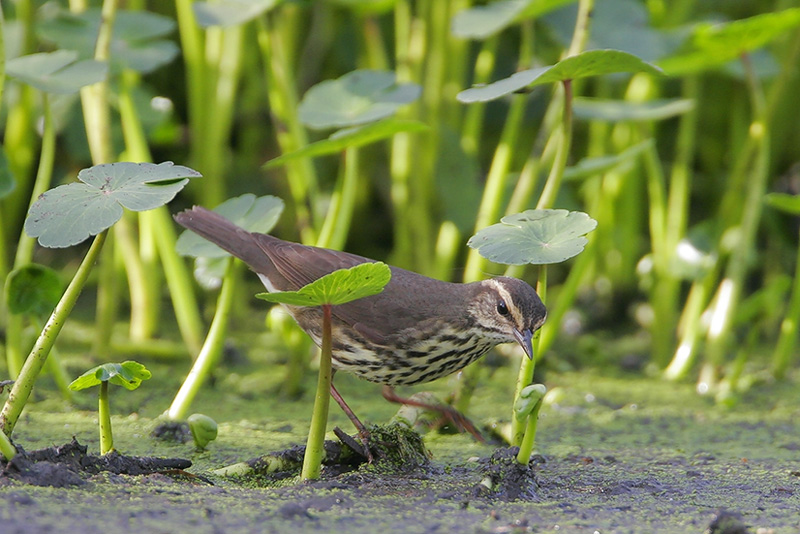
Northern Waterthrushes are usually found walking on the ground, typically along the edge of a stream, pond or other body of water in wooded areas. They almost constantly bob their tails while searching for food. Males and females look similar in both species of waterthrushes. Waterthrushes have an overall brown coloration with dark brown on top and buffy tones underneath. Northern Waterthrushes are heavily streaked beneath with fine but well defined streaks. The supercilium on Northern Waterthrushes is pale buff to white color and has a uniform width, possibly with slight tapering behind the eye. The legs tend to be dark flesh color to brownish. Northern Waterthrushes have a uniform tone below and have a smaller beak. The throat is often spotted but this is not always obvious.
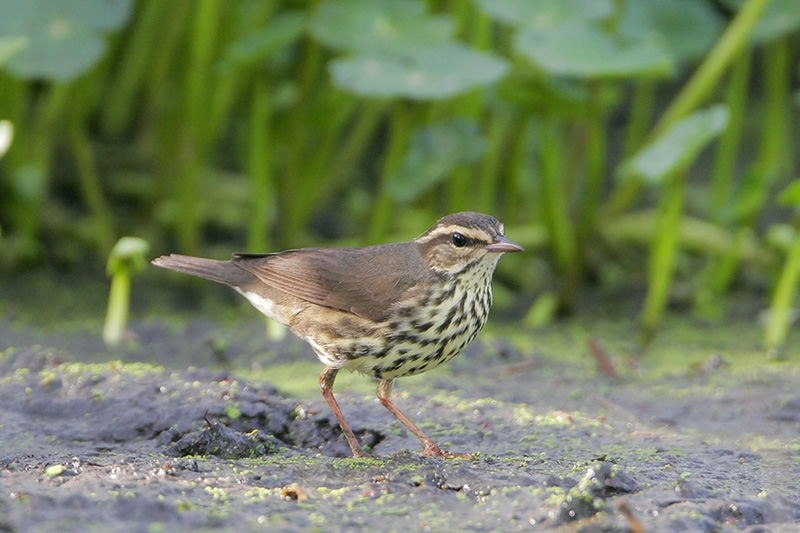
Compared to this Louisiana Waterthrush.

Note the large beak; the less coarse, less-defined streaks and the supercilium that transitions from buff color in front of the eye to white behind. It also flares behind the bird’s eye. Also note the contrast between the buffy flanks and the paler undertail coverts.

To see more of this species click here
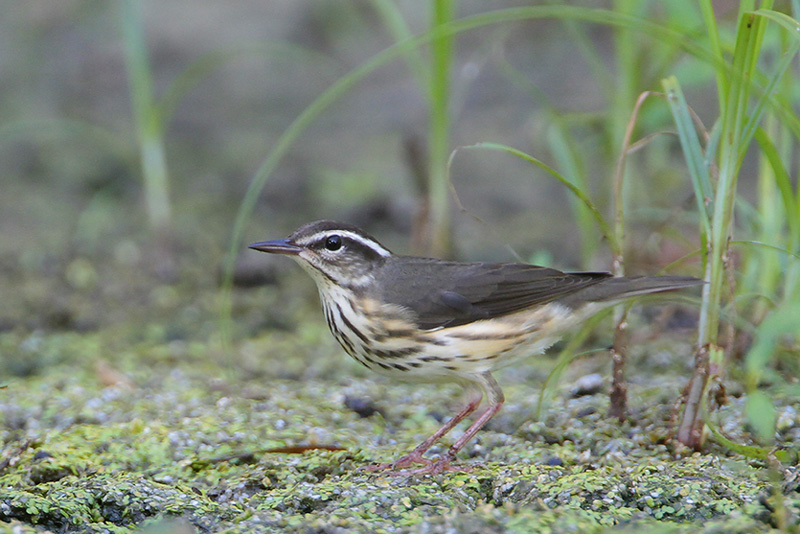
Louisiana Waterthrush (First week of March through second week of April) [wet areas] {feeds by walking on the ground, usually bobbing tail searching under dead leaves and crevices in fallen logs usually along the edge of water}
Though Louisiana Waterthrush is an early migrant and not a winter resident or year around resident, I chose to include it here so that it can be compared to the Northern Waterthrush more easily. Louisiana Waterthrush can be found during migration in similar habitats to those used by Northern Waterthrushes. I have personally witnessed heated debates between well informed birders about the idea of waterthrushes during migration and appreciate that separating the two species in the field is not a trivial task.
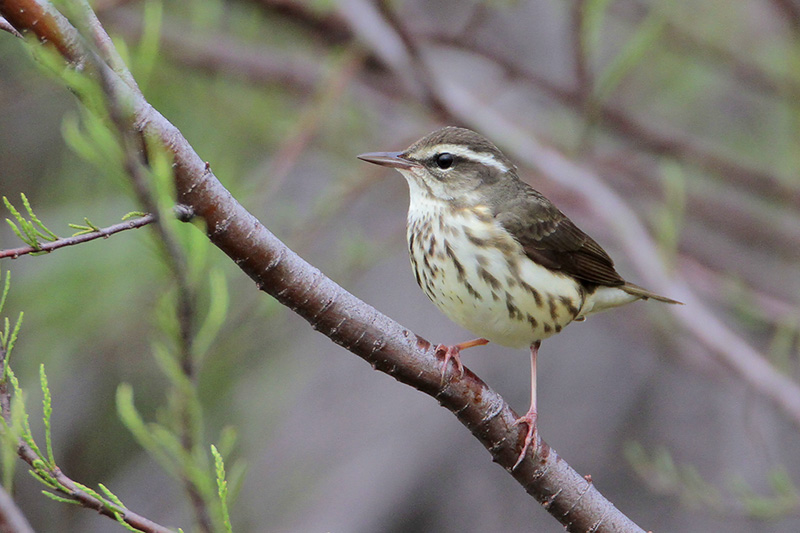
As stated earlier, Louisiana Waterthrushes usually start arriving in early March and get scarce by the second week of April. With these birds it is particularly important to try to gather as many fieldmarks as possible to make an ID. As can be seen here, the beak is usually bigger. The supercilium goes from buffy color in front of the eye to pale/white behind the eye and also broadens behind the eye. The legs on Louisiana Waterthrushes tend to be brighter pink and the throat on Louisiana Waterthrushes tend to be clear as can be seen here.
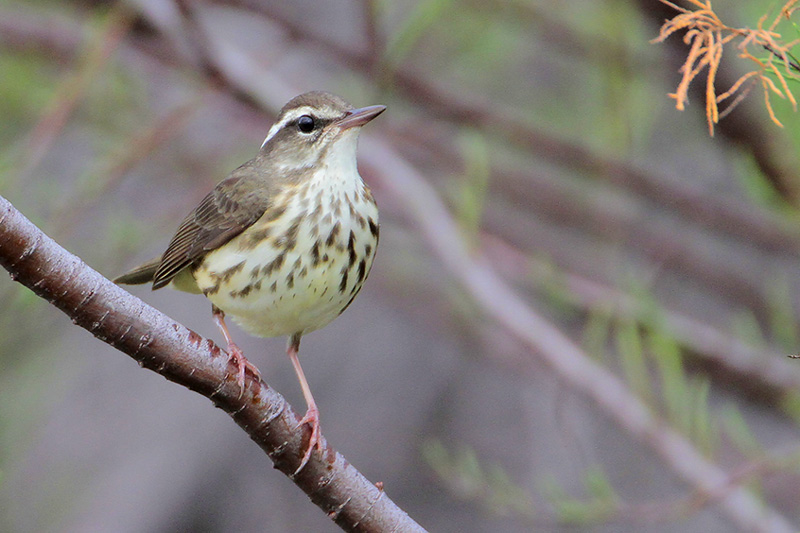
Compared to spotted in this Northern Waterthrush.
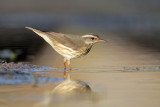
To see more of this species click here

Pine Warbler (year around resident) [wooded areas] {hunts insects along branches and tree trunks, picking insects from bark. Forages from mid-to high levels but can also be found feeding on the ground}
The Pine Warbler is the first of the two species of warbler that are year around residents of the UTC. They are typically found in pine forests as well as other wooded areas and can often be found feeding on the ground. Pine Warblers are sexually dimorphic and come in a variety of plumages ranging from bright yellow to dull gray.
Adult male
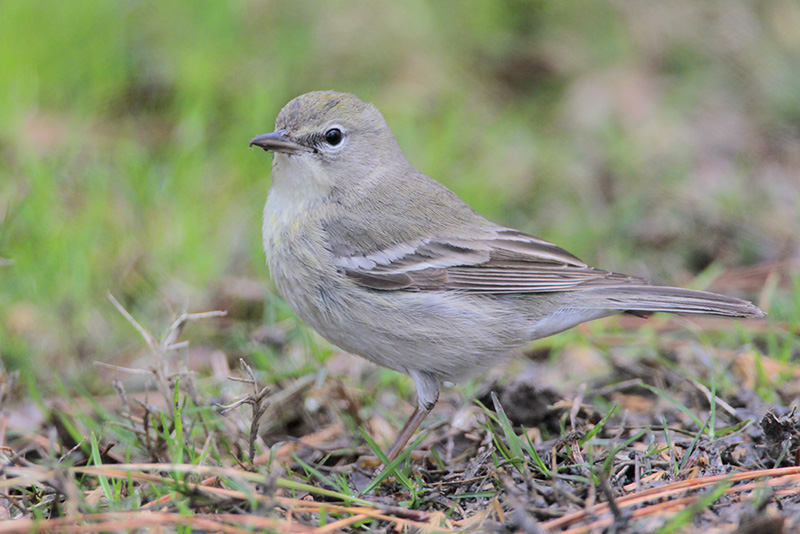
White wingbars and undertail coverts are important fieldmarks. Adult males have bright yellow unstreaked backs and throats with yellow faintly streaked breasts. The undertail coverts and belly are white. They are large for warblers and also can have yellow “goggles.” This, along with their large beak, can make them easy to confuse with Yellow-throated Vireos.

Compared to Yellow-throated Vireo
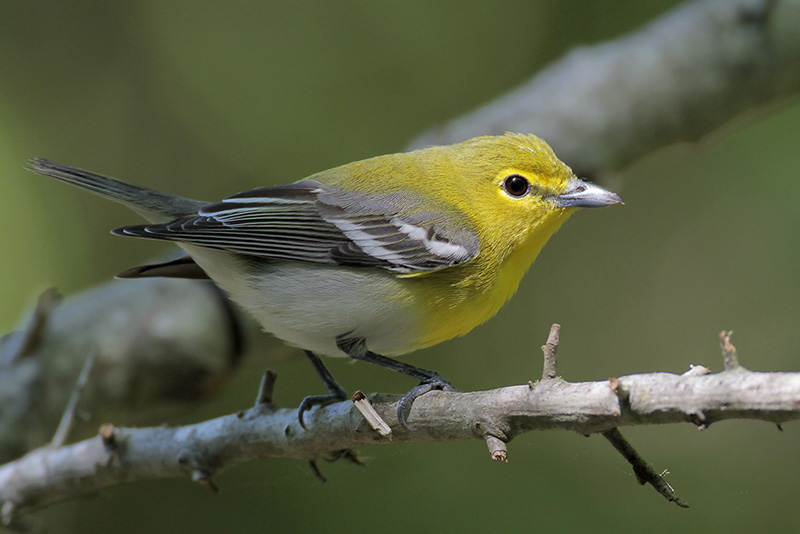
Finally, Pine Warblers have long white spots on their outer tail-feathers which can be seen during flight. From below the folded tail shows mostly white with dark corners.
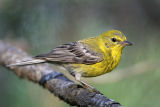
To see more of this species click here

Common Yellowthroat (year around resident) [marshy areas, prefers areas with dense undercover] {feeds in dense undergrowth}
Our other year around resident is the Common Yellowthroat which can be found in marshy areas, riparian thickets or weedy areas near water. Adult males are distinctive with their black facemasks bordered above with white and below by a bright yellow throat. They have an olive green tail, back and crown. Other fieldmarks include yellow undertail coverts and breasts bordered with dusky flanks.
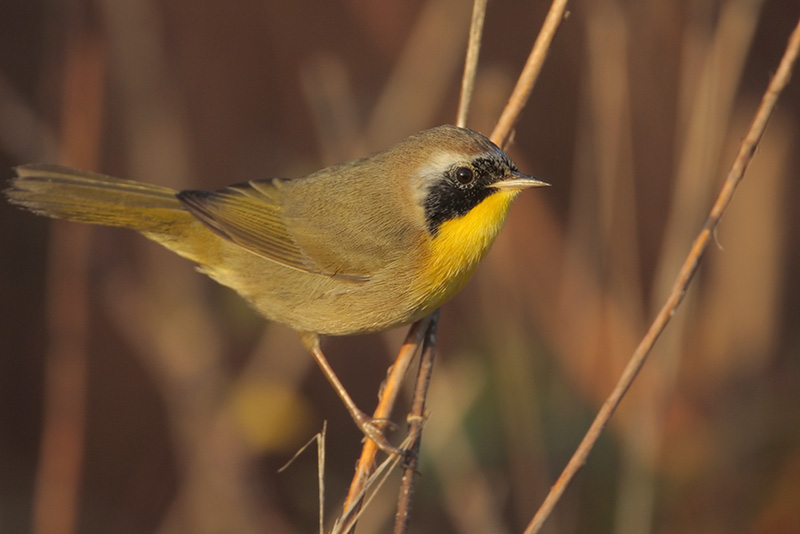
First year males lack the full black mask but are still easily identified.

Female Common Yellowthroats, and in particularly first year females can be tricky to identify. They are dull overall but still have yellow throats and undertail coverts but otherwise look nondescript. This makes them easy to confuse with female Mourning Warblers in the fall.
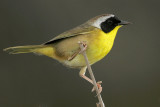
To see more of this species click here
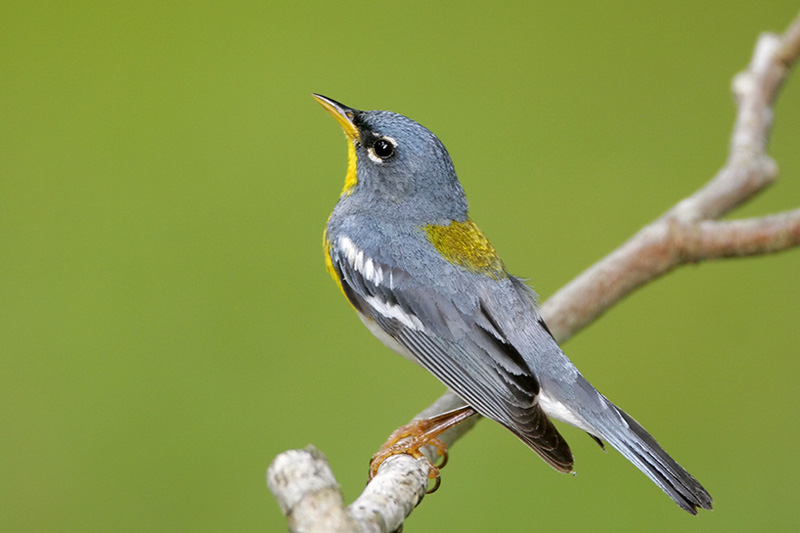
Northern Parula (First week of March through the summer) [woodlands] {usually feeds high in treetops but can also be found feeding near the ground in scrubby areas}
One of the first spring migrants to show up on the UTC is the Northern Parula, and it should come as no surprise that this species also breeds in the area. Parulas typically start showing up the first week of March and migrants continue through the month of May. Northern Parulas are normally found in wooded areas and often near water. They are very small warblers and are sexually dimorphic. Adult males are bluish gray on top with a triangular yellow-green patch on the middle of their back and white wingbars and eye-arcs.
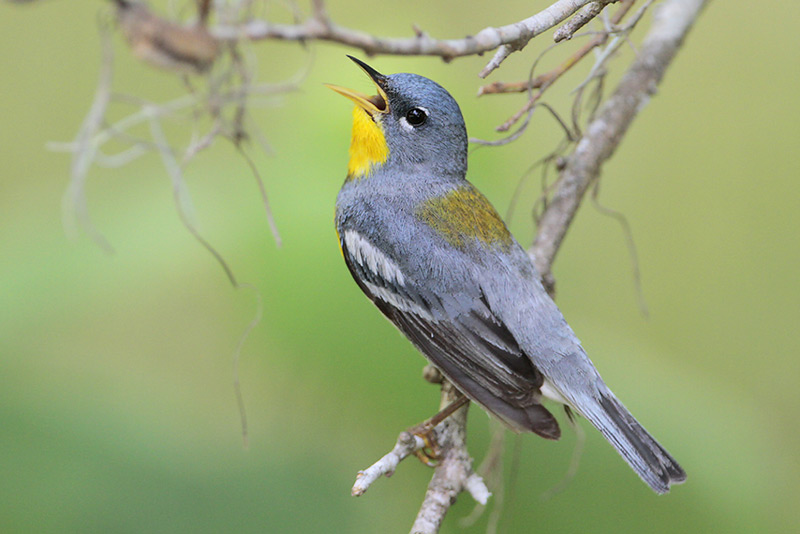
From below they have yellow throats along with white bellies and undertail coverts. Their breasts are yellow with rusty and black patches below the throat.
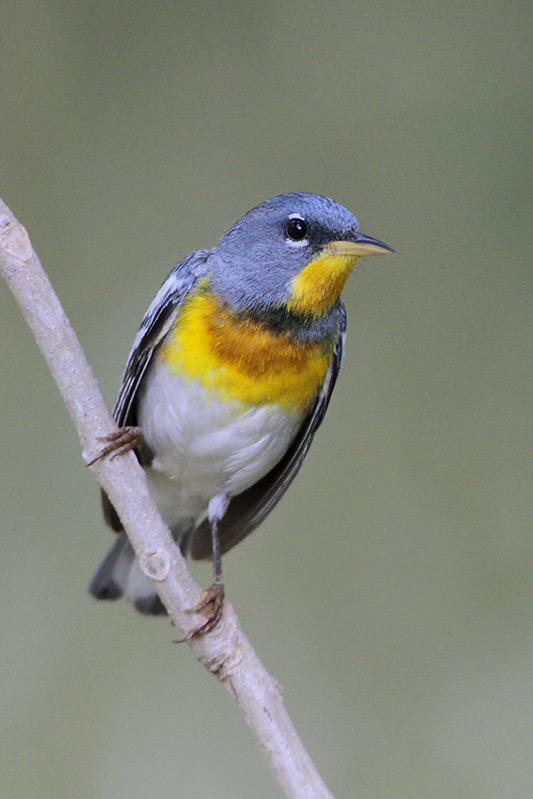
They have large white spots on the underside of their tails giving the folded tail a white appearance with a dark border.
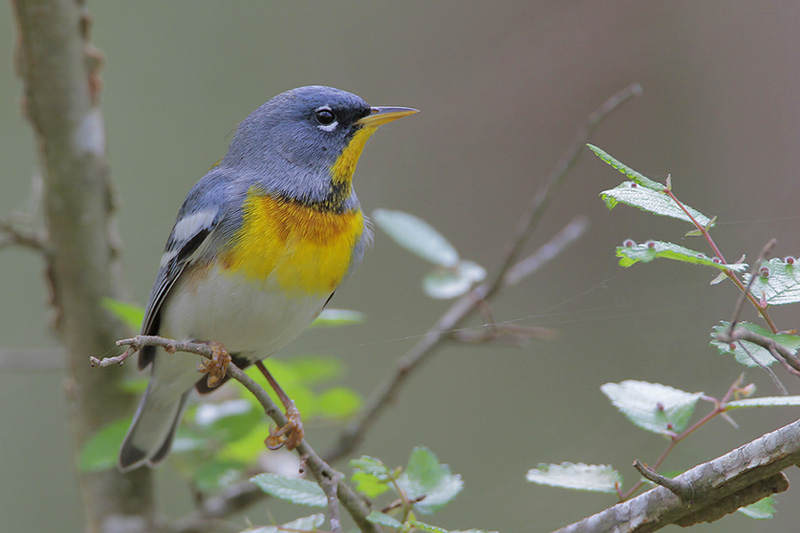
Females look similar to males but are duller overall and lack the black breast spot.

First year females even lack the rust-colored breast spot.

To see more of this species click here
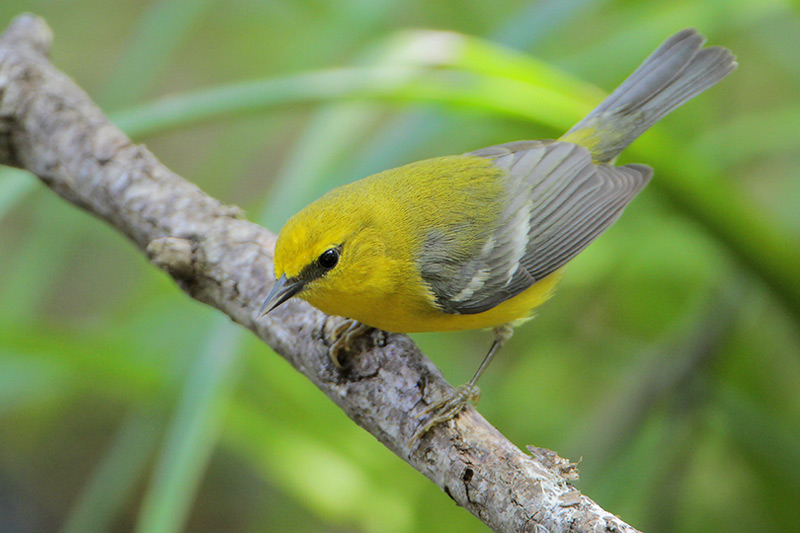
Blue-winged Warbler (Third week of March though the end of April) [Brushy second growth habitat and woodland edges] {gleans insects, frequently probes dead leaf clusters and sometimes hovers to pick insects from vegetation; usually found about mid-level}
Blue-winged Warblers are one of those bird species that I think is misnamed since they appear to me to have gray wings at best. These birds are typically found in brushy, open woodland and in patches of second-growth forest. They are mildly sexually dimorphic with females being a bit duller in appearance than males and first year females being duller still. They have long pointed beaks.
Adult male:
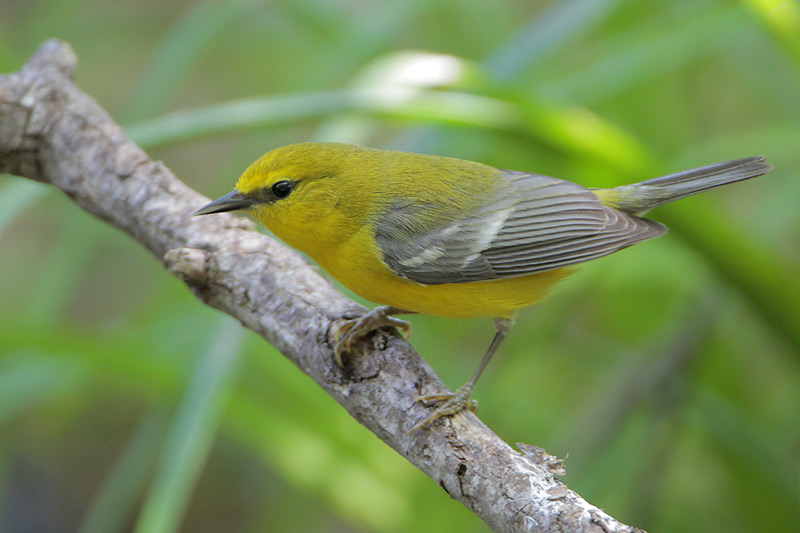
Blue-winged Warblers are yellow overall with bluish-gray wings and white wingbars. They have large spots on the underside of the tail and a black eye-stripe and white undertail coverts. The white spots on the tail give the folded undertail a white appearance with dark gray corners.
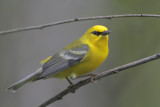
To see more of this species click here
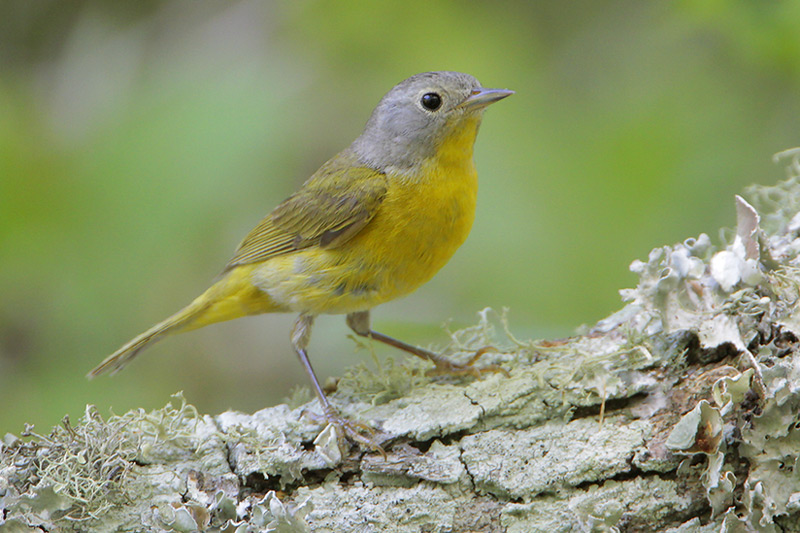
Nashville Warbler (Forth week of March through the end of April) [woodlands] {usually forages low but sometimes forages in treetops}
Nashville Warbler is another sharp beaked warbler and another with a variety of different plumages. These warblers are birds of the woods and brushy areas. Nashville Warblers are small with a bold complete eye-ring on a gray head. Their bodies are yellow to yellow-green and adult males have a rusty crown patch.

Females are similar to males but duller in appearance and with less contrast between head and back.

Undertail coverts are yellow and the bottom of the tail is gray and lacking white spots.

Nashville Warblers start showing up on the UTC around the last week of March and continue through the end of April. In the spring they don’t usually occur in large numbers.
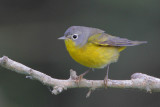
To see more of this species click here
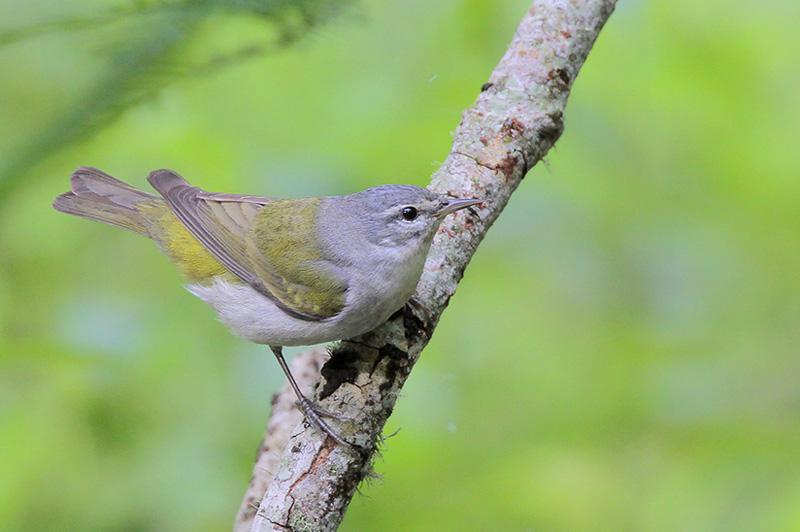
Tennessee Warbler (first week in April through third week of May) [wooded areas] {usually forages high; is often seen hanging upside down in clumps of leaves, often probes the ends of branches/twigs with its beak}
One of the less flashy of the warbler migrants is the Tennessee Warbler. They are often confused with Orange-crowned Warblers and Red-eyed Vireos. They have olive-green backs and white undertail coverts and a thin wingbar. A dark eye-line is also pretty obvious in most birds. Adult males have a gray head that contrasts strongly with the green back.
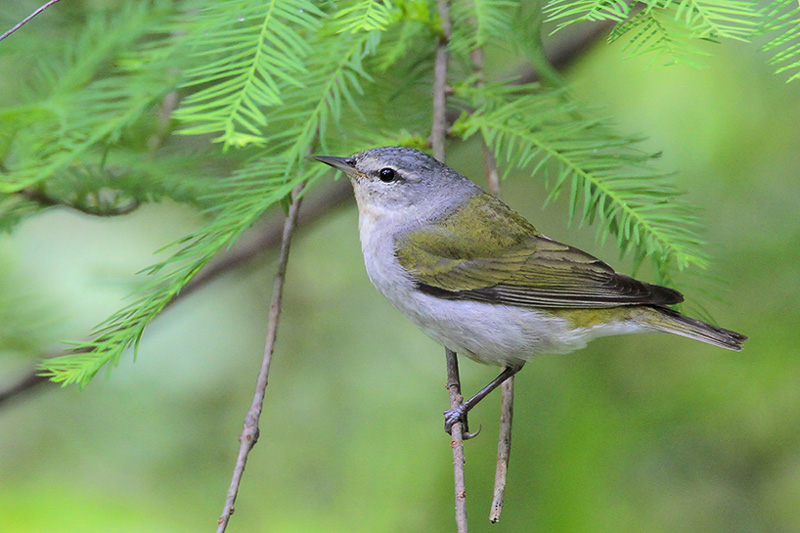
Female birds are duller overall with more yellow on the underparts and a fainter eye-line.

Non-breeding males have more of a greenish tinge to the gray head and a yellow wash on the underparts.

For comparison take a look at this Red-eyed Vireo.
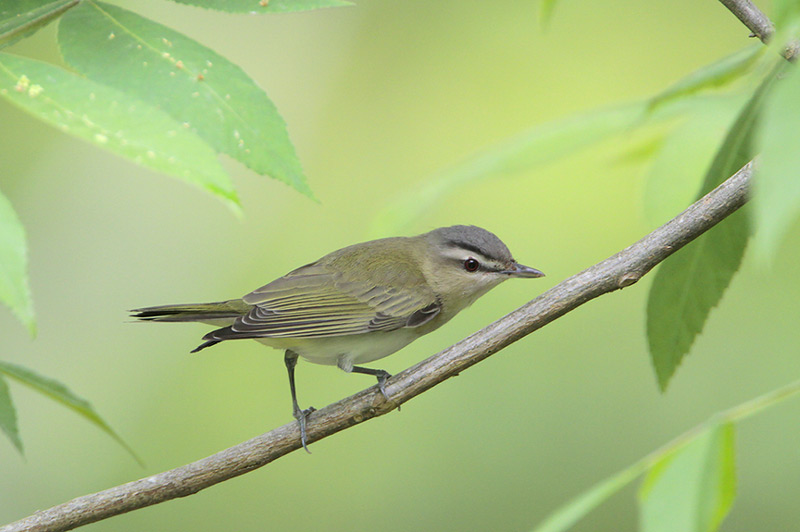
The vireo is a larger bird with a very different looking beak.

To see more of this species click here

Black-throated Green Warbler (First week of April through mid-May) [wooded areas and scrubby areas] {feeds at all levels but mostly mid to high}
Black-throated Green Warblers start to arrive on the Texas coast during the first week of April and can be found until mid-May. They are sexually dimorphic and are woodland birds on their way to coniferous forests further north. Adult males have a distinctive black trough and upper breast with bold black stripes down their sides. The crown and ear patches are greenish. They have black lores that merge into the greenish ear-patches to form a distinctive facial pattern on an otherwise bright yellow face. The belly and undertail coverts are white. These birds also have white wingbars and large white spots on the outer tailfeathers. The nape and back are olive green.

Female birds have a pattern very similar to males but duller overall and with less black on the underparts.
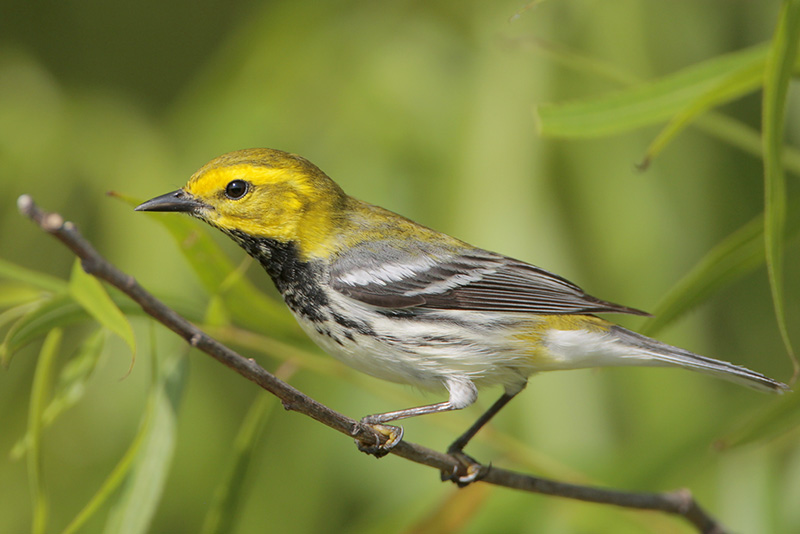
First year females are duller still with very little black on the underparts.

The underside of the folded tail is white.
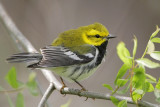
To see more of this species click here
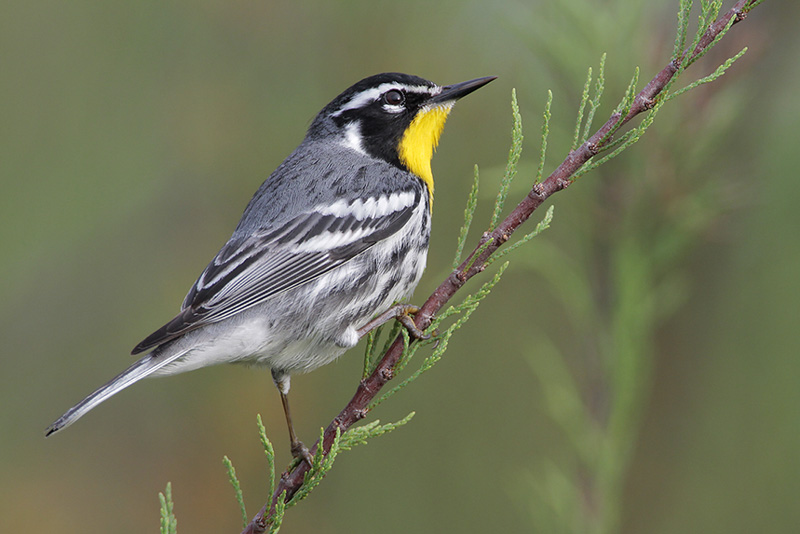
Yellow-throated Warbler (First week of March through second week of April though some breed on the UTC) [wooded areas] {usually forages high in treetops, moving along branches and probing crevices with its long beak}
One of my all-time favorite warblers that migrates through the upper Texas coast is the Yellow-throated Warbler. They start arriving around the second week of March and the bulk of migrants have passed through by the middle of April. Yellow-throated Warblers prefer live oak, cypress and pine woodlands. They usually forage in the canopy using their long beaks to pick insects from crevices in bark. When foraging they tend to be slow moving though they are also known to fly-catch.
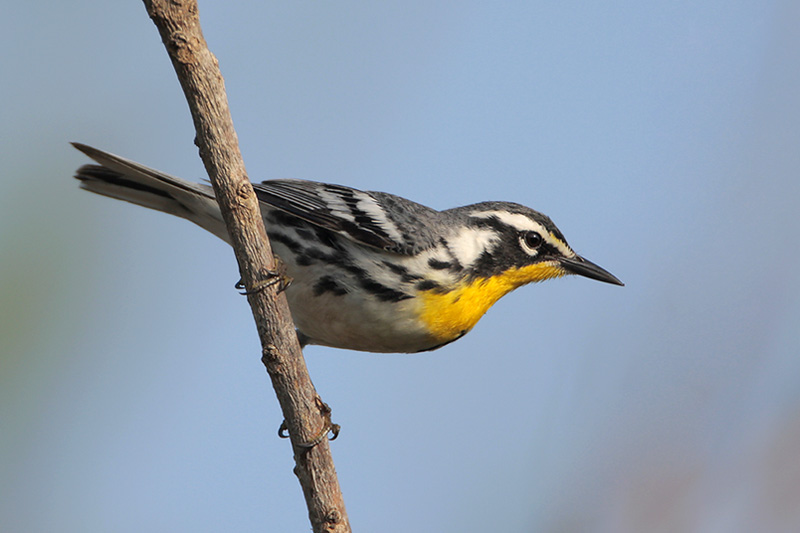
All plumages are similar though females and youngsters tend to be a bit duller than adult males. The bright yellow throat and breast are the most distinctive features along with the black face with white supercilium and white neck patch. They have white wingbars and black streaks on their sides and large white spots on their outer tail-feathers.
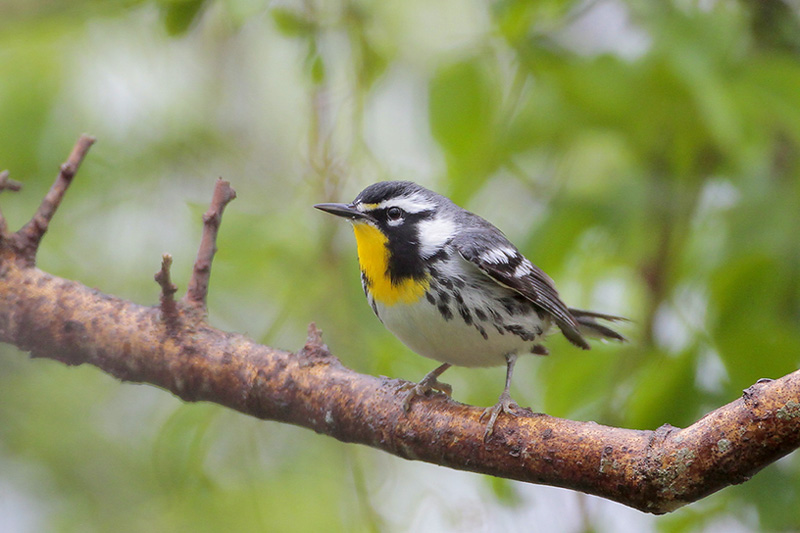
The pattern of the underside of the tail is mostly white or white with slight black edges near the end of the tail and some black at the base of the tail. First-year females can show more black at the base of the tail.

To see more of this species click here
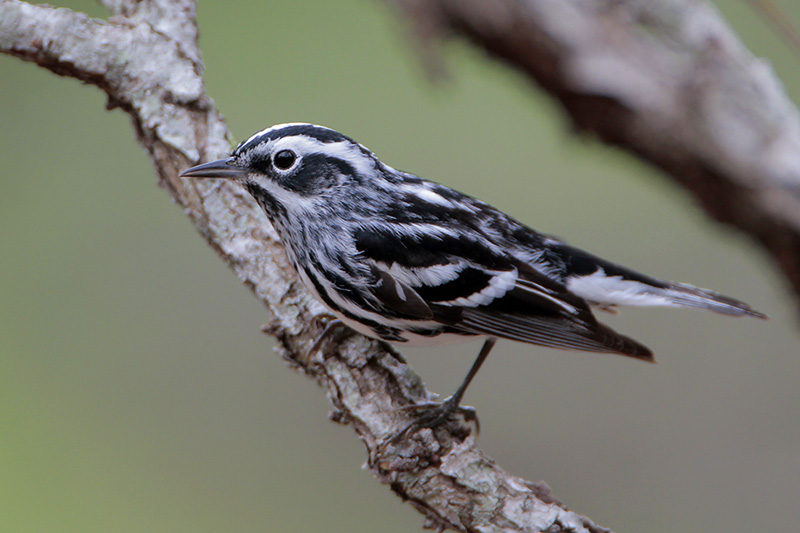
Black-and-white Warbler (Some winter on the UTC but migrants start around the first week of March through middle of May) [wooded areas and scrub] {moves along tree trucks and large branches probing bark with its beak}
The Black-and-white Warbler might not be very colorful but what it lacks in color it makes up for with its beautiful markings. They feed by creeping up and down tree trunks and main branches using their long beaks to probe crevices.
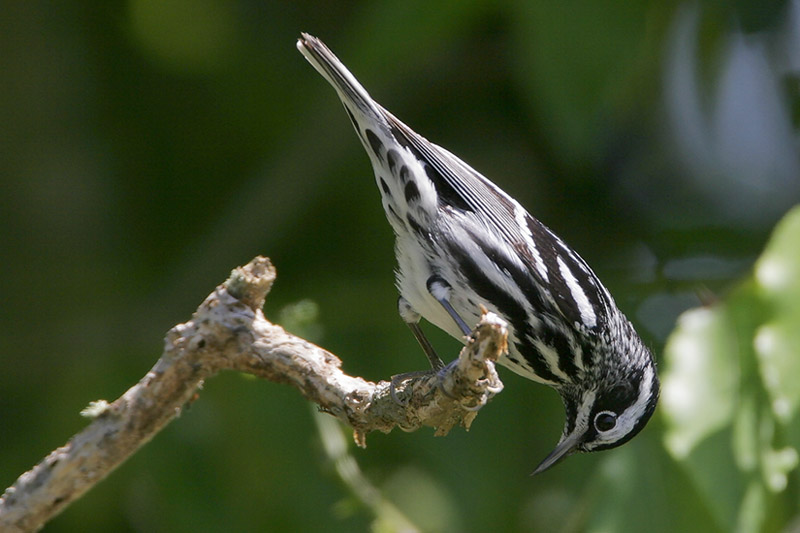
Black-and-white Warblers are found in a variety of wooded habitats and can be found on the UTC from around the second week of March through middle of May. They do winter on the upper Texas coast in small numbers.

These birds are sexually dimorphic. Males have black throats and ear-coverts.
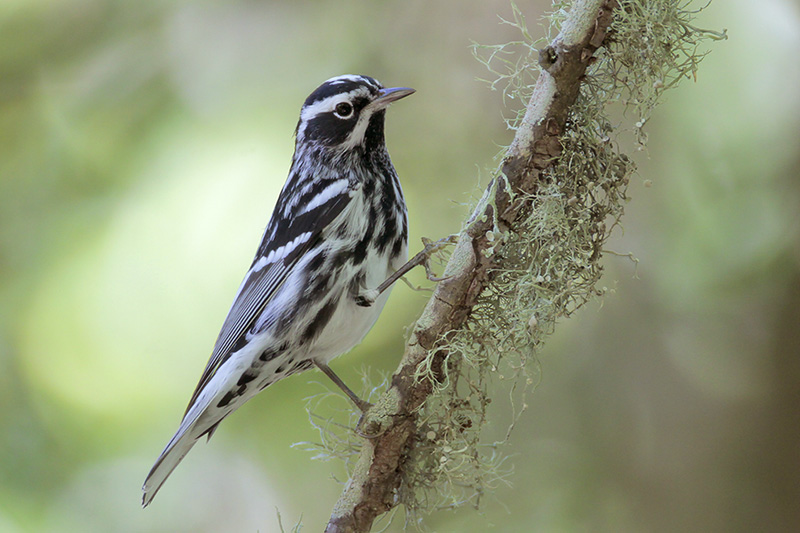
Females have white throats and light colored ear-coverts.
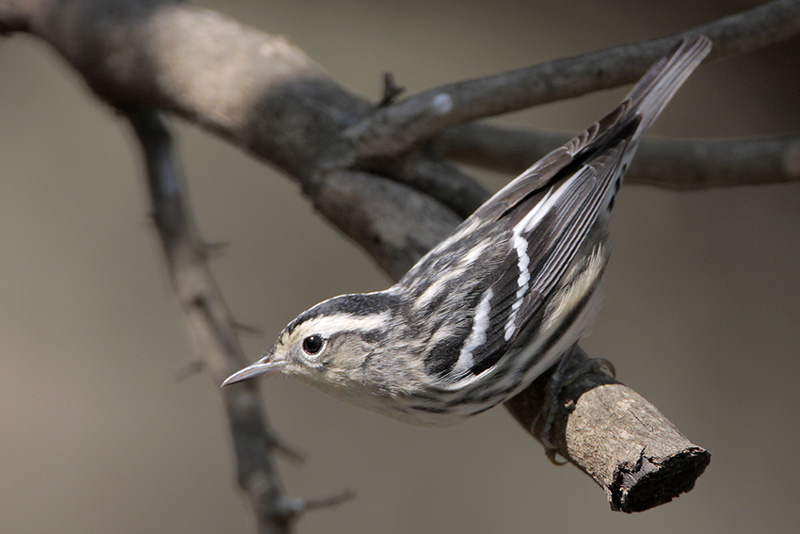
Many young females have buffy flanks and undertail-coverts.

Prairie Warbler (first two weeks of April in very small numbers) [scrub and woodland edges] {feeds mainly at mid to low levels in the undergrowth and on the ground}
As we are on the extreme eastern edge of the Prairie Warbler’s breeding range we get very few of them during migration on the upper Texas coast. Males and females look similar with females looking duller overall with less distinct markings.
The undertail is mostly white with dark at the outer edges of the tip.
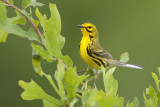
To see more of this species click here
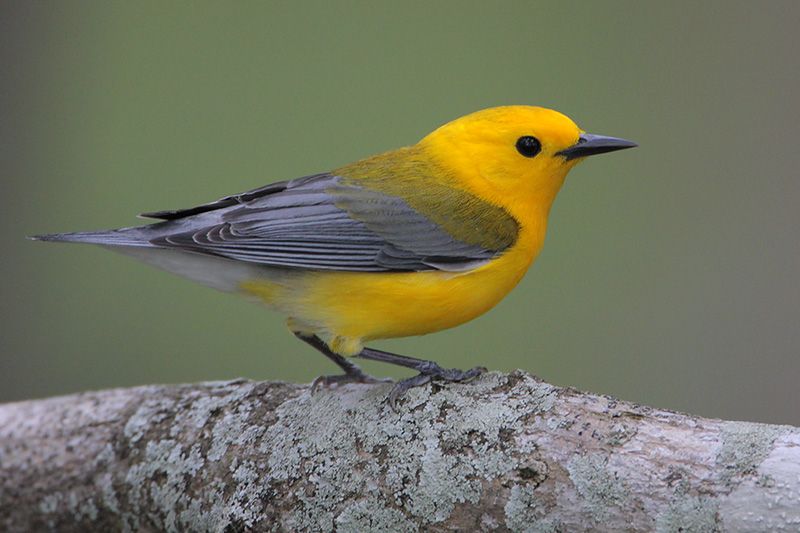
Prothonotary Warbler (Mid-March through the summer) [prefers wet wooded areas but can also be found in dry wooded areas] {forages at low to mid levels}
Of all the birds in North America my all time favorite has to be the Prothonotary Warbler. I will never forget the first time I saw one at Brazos Bend State Park so many springs ago. The warblers like to hang out in wooded swamps and are unmistakable. They have a golden-yellow head, breast and belly; white undertail coverts; silvery gray tail and wings and a greenish back. The black eye and beak in the spring are also distinctive on the bright yellow head.
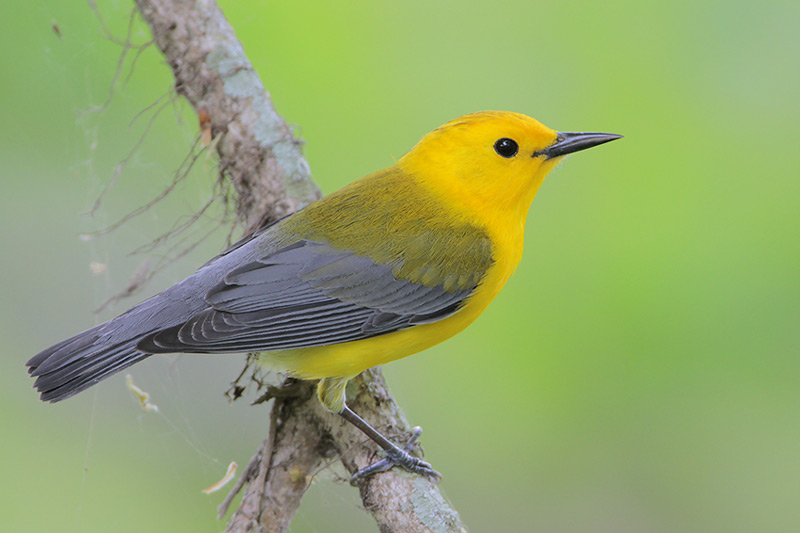
Prothonotary Warblers are sexually dimorphic with females and immature birds looking similar to adult males but with duller yellow.
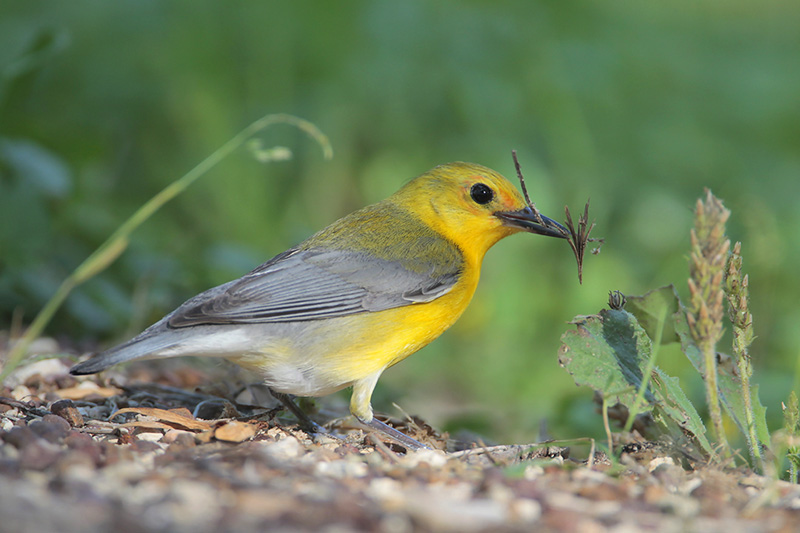
Prothonotary Warblers start to show up on the UTC around the last week of March and migrants can be found at coastal woodlots until the first week of May.

The folded undertail is mostly white with a dark tip.
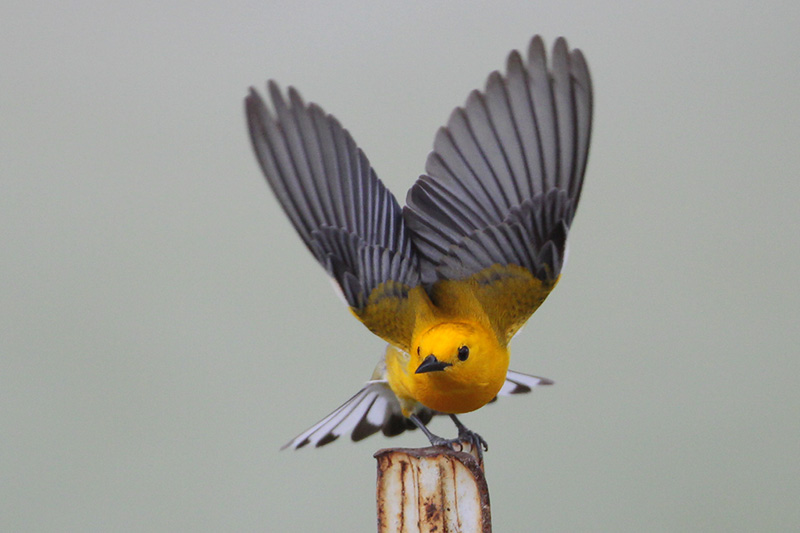
Sometimes during migration Prothonotary Warblers feed on nectar and fruit which can stain the tops of their heads as can be seen in this individual:

To see more of this species click here
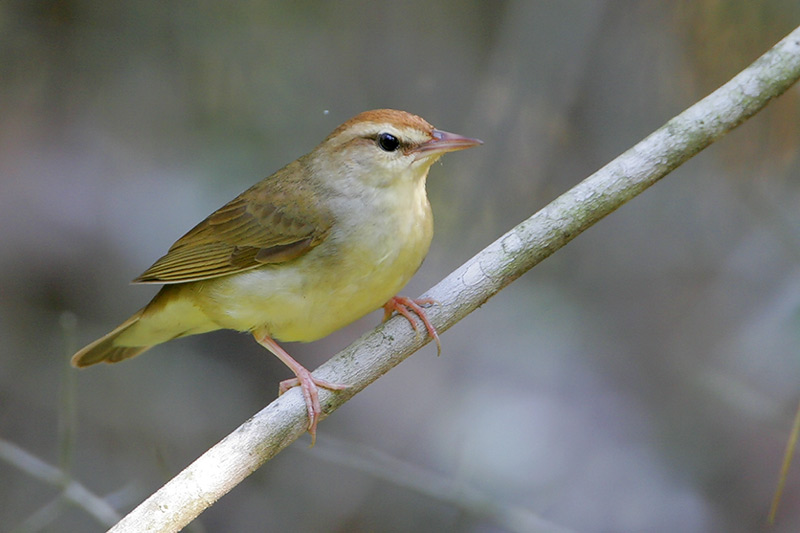
Swainson’s Warbler (last week of March through the summer) [wooded areas with dense undergrowth and wooded swamps] {feeds mainly on the ground probing leaf litter, also feeds in low shrubs and on rotting logs}
Swainson’s Warblers start showing up on the Texas coast during the first week of April. Though they probably pass through in fairly good numbers, they are very difficult to detect in migration.

Male and female Swainson’s Warblers look similar and are usually found in riparian areas with dense undergrowth. These birds are fairly drab with a brown crown and nape and an off-white supercilium. They have a very large beak that makes them look flat headed.

To see more of this species click here
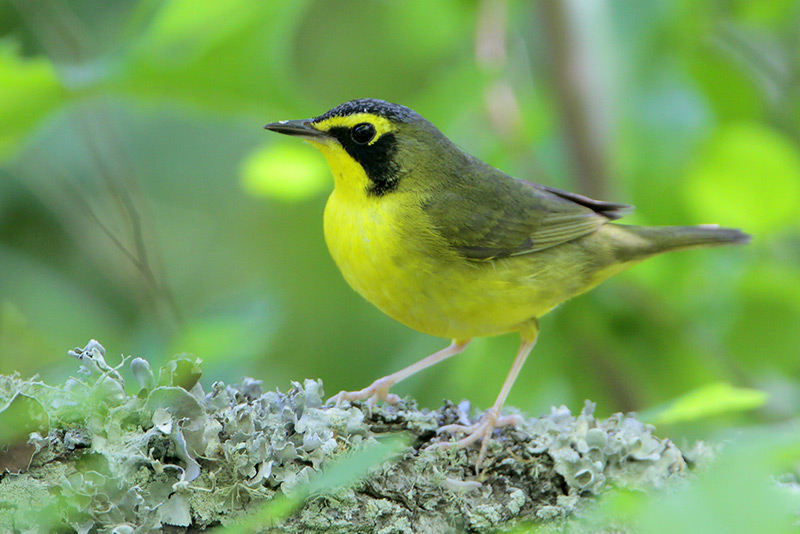
Kentucky Warbler (Last week of March through the first week of May but some breed on the UTC) [wooded areas with dense undergrowth] {forages mainly on the ground, turning dead leaves, also forages in low bushes}
Another secretive early migrant is the Kentucky Warbler which starts showing up on the UTC around the last week of March. They are large chunky warblers with greenish backs and yellow underparts and a distinctive black facial pattern.
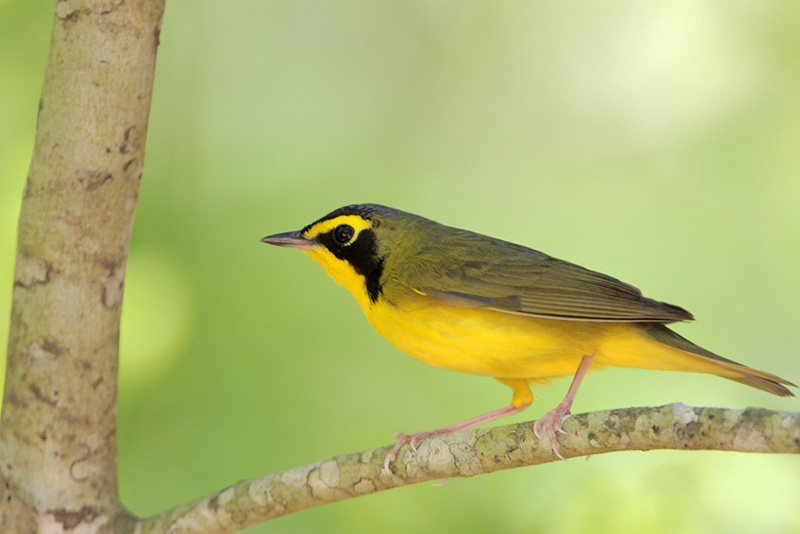
Like the Swainson’s Warbler, Kentucky Warblers like dense vegetation and stay near the ground. They are sexually dimorphic with the female being similar to the male with less extensive markings on the head and less black on the crown.
Male
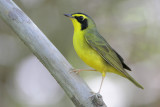
To see more of this species click here
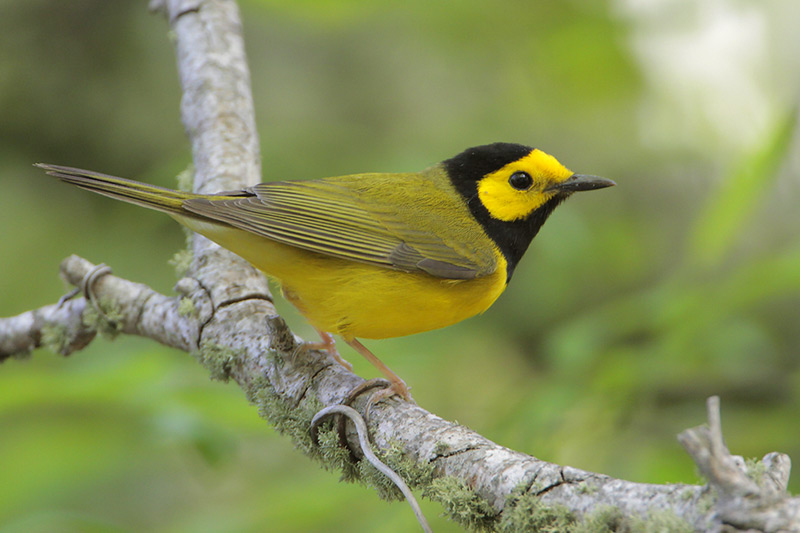
Hooded Warbler (Second week in March through the first week in May though some breed on the UTC) [wooded areas with dense undergrowth and tall scrub] {forages mainly in the understory and on the ground. Also flycatches from low perches. Frequently flicks open its tail exposing white spots to startle prey}
The last of the early warbler migrants on the UTC is the Hooded Warbler. This species is sexually dimorphic with the males being quite distinctive with their black throat and crown surrounding a yellow face. Females, particularly young ones, can be tougher to identify.
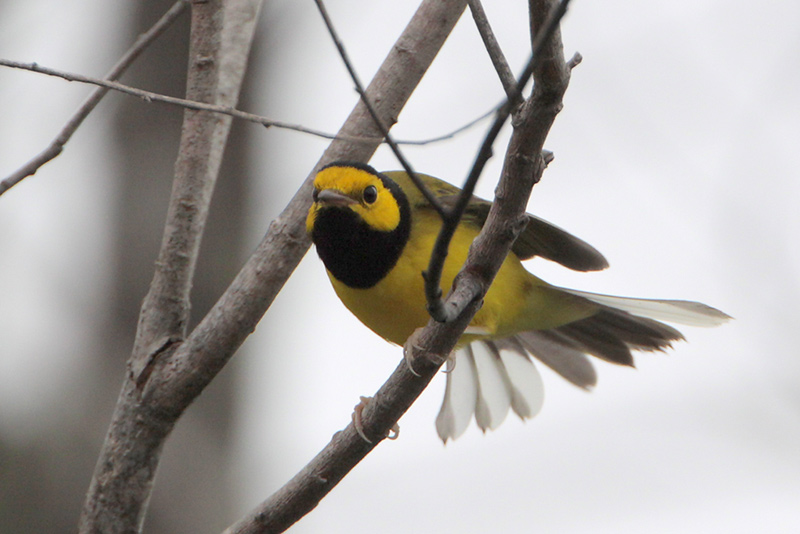
The black on the female birds is sparse.

Hooded Warblers prefer wooded habitats with dense understory and forage near the ground, frequently flashing the white spots on their tail to startle prey.
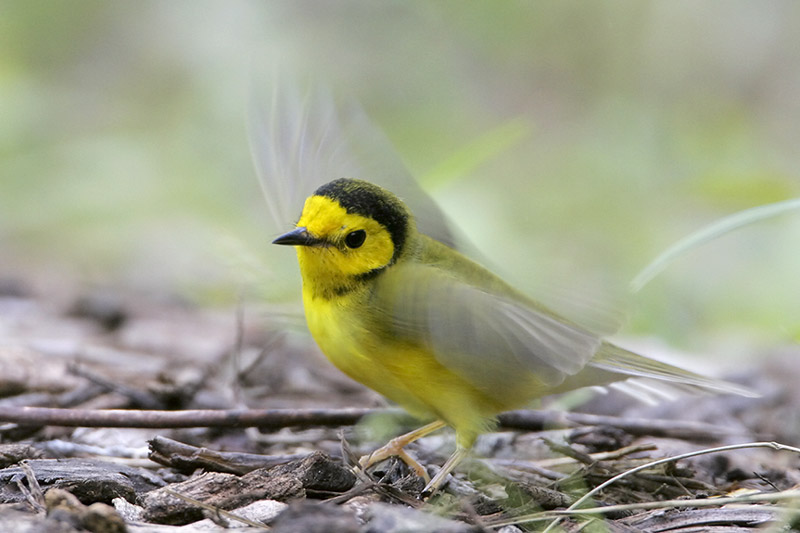
From beneath, the undertail coverts are yellow with white tail feathers that have gray at the outer edges of the tip of the tail.
| Rolling Harbour (Abaco) | 01-Mar-2015 20:28 | |
| Walt Cole | 01-Nov-2013 15:02 | |
| Monte Stinnett | 28-Sep-2013 05:51 | |
| Howard Wu | 07-May-2013 03:03 | |